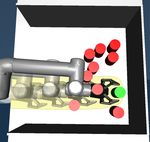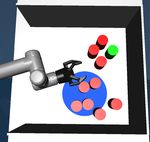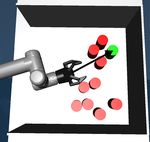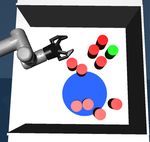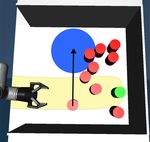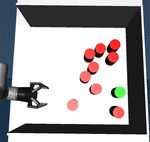Human-Guided Planner for Non-Prehensile Manipulation
←
→
Page content transcription
If your browser does not render page correctly, please read the page content below
Human-Guided Planner for Non-Prehensile Manipulation
Rafael Papallas and Mehmet R. Dogar
Abstract— We present a human-guided planner for non-
prehensile manipulation in clutter. Most recent approaches to og
manipulation in clutter employs randomized planning, however, o2
the problem remains a challenging one where the planning
times are still in the order of tens of seconds or minutes,
and the success rates are low for difficult instances of the
problem. We build on these control-based randomized planning
arXiv:2004.00946v2 [cs.RO] 4 Apr 2020
approaches, but we investigate using them in conjunction with (a) (b) (c)
human-operator input. We show that with a minimal amount
of human input, the low-level planner can solve the problem
faster and with higher success rates.
I. I NTRODUCTION
We present a human-guided planner for non-prehensile (d) (e) (f)
manipulation in clutter. We show example problems in Figs. 1
and 2. The target of the robot is to reach and grasp the green Fig. 1: A human-operator guiding a robot to reach for the
object. To do this, however, the robot first has to push other green goal object, og . Arrows indicate human interaction with
objects out of the way (Fig. 1b to Fig. 1e). This requires the the robot. In (a) the operator indicates o2 to be pushed to the
robot to plan which objects to contact, where and how to blue target region. From (a) to (c) the robot plans to perform
push those objects so that it can reach the goal object. this push. In (d) the operator indicates to the robot to reach
These reaching through clutter problems are difficult to for the goal object. From (d) to (f) the robot plans to reach
solve due to several reasons: First, the number of objects the goal object.
make the state space of high-dimensionality. Second, this is an
underactuated problem, since the objects cannot be controlled planning. Haustein et al. [4] use a kinodynamic RRT [12],
by the robot directly. Third, predicting the evolution of [13] planner to sample and generate a sequence of robot
the system state requires running computationally expensive pushes on objects to reach a goal state. Muhayyuddin et al.
physics simulators, to predict how objects would move as [5] use the KPIECE algorithm [14] to solve this problem.
a result of the robot pushing. Effective algorithms have These planners report some of the best performance (in terms
been developed [1]–[11], however the problem remains a of planning times and success rates) in this domain so far.
challenging one, where the planning times are still in the We build on these kinodynamic planning approaches, but
order of tens of seconds or minutes, and the success rates we investigate using them in conjunction with human-operator
are low for difficult problems. input. In our framework, the human operator supplies a high-
Further study of the reaching through clutter problem is level plan to make the underlying planners solve the problem
important to develop approaches to solve the problem more faster and with higher success rates.
successfully and faster. It is a problem that has a potential for
major near-term impact in warehouse robotics and personal II. P ROBLEM F ORMULATION
home robots. The algorithms that we currently have, however, Our environment is comprised of a robot r, a set of movable
are not able to solve reaching through clutter problems in obstacles O, and other static obstacles. The robot is allowed
the real world in a fast and consistent way. Here, we ask the to interact with the movable obstacles, but not with the static
question of whether human-operators can be used to provide a ones. We also have og ∈ O which is the goal object to reach.
minimal amount of input that results in a significantly higher We are interested in problems where the robot needs to
success rate and faster planning times. reach for an object in a cluttered shelf that is constrained
Most recent approaches to the reaching through clutter from the top, and therefore we constrain the robot motion
problem employs the power of randomized kinodynamic
This research has received funding from the European Union’s Horizon
2020 research and innovation programme under the Marie Sklodowska-Curie
grants agreement No. 746143, and from the UK Engineering and Physical
Sciences Research Council under grant EP/N509681/1, EP/P019560/1 and
EP/R031193/1. (a) (b) (c) (d)
Authors are with the School of Computing, University of Leeds, United
Kingdom {r.papallas, m.r.dogar}@leeds.ac.uk Fig. 2: Human-operator guiding a robot in the real-world.to the plane and its configuration space, Qr , to SE(2). The
configuration of a movable object i ∈ {1, . . . , |O|}, q i , is its d (xi , yi ) d (xi , yi )
pose on the plane (x, y, θ). We denote its configuration space qa1 qa2
as Qi . The configuration space of the complete system is the
Cartesian product Q = Qr × Qg × Q1 × · · · × Q|O|−1 . Fig. 3: Approaching states: The blue circle is the target region,
Let q0 ∈ Q be the initial configuration of the system, the red rectangle the object to manipulate. We compute two
and Qgoals ⊂ Q a set of possible goal configurations. A approaching states, qa1 and qa2 .
goal configuration, qn ∈ Qgoals , is defined as a configuration
where og is within the robot’s end-effector (see Fig. 1f). state to push the object to its target region. Specifically, given
Let U be the control space comprised of the robot velocities. an object to push, oi , we compute two approaching states qa1
Let the system dynamics be defined as f : Q × U → Q that and qa2 (line 6). Fig. 3 shows how these approaching states are
propagates the system from qt ∈ Q with a control ut ∈ U . computed, based on the object’s current position, the centroid
We define the Reaching Through Clutter (RTC) problem as (xi , yi ) and the minimum enclosing circle of the object. The
the tuple (Q, U, q0 , Qgoals , f ). The solution to the problem approaching state qa1 encourages side-ways pushing, where
is a sequence of controls from U that move the robot from qa2 encourages forward pushing. We also experimented with
q0 to a qn ∈ Qgoals . planning without first approaching the object but we found
III. S AMPLING - BASED K INODYNAMIC P LANNERS that approaching the object from a good pose yields to faster
pushing solutions. Using both approaching states as the goal
Two well known sampling-based kinodynamic planners we plan to move to one of them (multi-goal planning) on
are Rapidly-exploring Random Trees (RRT) [12], [13] and line 7. Then, from the approaching state reached (either qa1
Kinodynamic Motion Planning by Interior-Exterior Cell or qa2 ) we push oi to its target region (line 9). If any of the
Exploration (KPIECE) [14]. We use kinodynamic RRT and two planning calls on lines 7 and 9 fails, then the algorithm
KPIECE in our work in two different ways: (1) as baseline proceeds to the next high-level action (line 4). Otherwise, we
RTC planners to compare against, and (2) as the low-level execute the solutions sequentially on line 11, which changes
planners for the Guided-RTC Framework that accepts high- the current system configuration qcurrent .
level actions (explained in Sec. IV). Alg. 1 runs up to an overall time limit, Toverall , or until a
In this work, when we plan with a kinodynamic plan- goal is reached. The pushing planning calls on lines 7 and 9
ner (either RRT or KPIECE) we will use the notation have their own shorter time limit, Tpushing , and they should
kinodynamicPlanning(qstart , goal) with a start configuration find a valid solution within this limit. The planning call on
of the system, qstart , and some goal input. line 13 is allowed to run until the overall time limit is over.
IV. G UIDED -RTC F RAMEWORK
B. Guided-RTC with Human-In-The-Loop (GRTC-HITL)
In this section we describe a guided system to solve RTC
problems. A Guided-RTC system accepts high-level actions. Guided-RTC with Human-In-The-Loop (GRTC-HITL) is
A high-level action can suggest to push a particular obstacle an instantiation of the GRTC Framework. A human-operator,
object into a certain region, or it may suggest to reach for through a graphical user interface, provides the high-level
the goal object. We formally define a high-level action with actions. In Alg. 2 we present GRTC-HITL N EXT H IGH -
the triple (oi , xi , yi ), where oi ∈ O is an object, and (xi , yi ) L EVEL ACTION function (referenced in Alg. 1, line 4).
is the centroid of a target region that oi needs to be pushed The human provides high-level actions until she selects
into. The target region has a constant diameter d.
In this work, we investigate how a Guided-RTC system Algorithm 1 Guided-RTC
with a human-in-the-loop performs when compared with (a) 1: procedure GRTC(Q, U, q0 , Qgoals )
solving the original RTC problem directly using kinodynamic 2: qcurrent ← q0
approaches (Sec. III), and (b) using Guided-RTC systems 3: do
with automated ways of generating the high-level actions. 4: oi , xi , yi ← N EXT H IGH L EVEL ACTION (qcurrent )
A. A Generic approach for Guided-RTC Planning 5: if oi 6= og then
6: qa1 , qa2 ← compute approaching states to oi
We present a generic algorithm for Guided-RTC in Alg. 1. 7: kinodynamicPlanning(qcurrent , {qa1 , qa2 })
The next high-level action is decided based on the current 8: if planning fails then continue
configuration (line 4). If the object in the high-level action 9: kinodynamicPlanning(qa1 or qa2 , (oi , xi , yi ))
is not the goal object (line 5), then it is pushed to the target 10: if planning fails then continue
region between lines 6 and 11, and a new high-level action 11: qcurrent ← execute solutions from lines 7 and 9
is requested. If it is the goal object, the robot tries to reach
12: while oi 6= og
it between lines 13 and 15 and the system terminates.
13: kinodynamicPlanning(qcurrent , Qgoals )
We plan to push an object to its target region in two steps.
14: if planning succeeds then
On line 7 we plan to an intermediate approaching state near
15: qcurrent ← execute solution from line 13
the object, and then on line 9, we plan from this approachingAlgorithm 2 GRTC-HITL
1: function N EXT H IGH L EVEL ACTION(qcurrent )
2: oi ← get object selection from human operator
3: if oi 6= og then
4: xi , yi ← get region centroid from human operator (a) S1 (b) S2 (c) S3 (d) S4
5: return oi , xi , yi
Fig. 5: Initial states of different problems in simulation (S1-
6: return og S4). Goal object is in green.
Success Rate (%)
100
Algorithm 3 GRTC-Heuristic Planner 80
60
1: function N EXT H IGH L EVEL ACTION(qcurrent ) 40
2: ob ← find the first blocking obstacle to og 20
0
3: if there exists a blocking obstacle ob then S1 S2 S3 S4 S5 S6 S7 S8 S9 S10
4: xb , yb ← find collision-free placement of ob 300
250
return ob , xb , yb
Time (s)
5: 200
150
6: return og . No blocking obstacle, reach the goal 100
50
0
S1 S2 S3 S4 S5 S6 S7 S8 S9 S10
the goal object, og . The GRTC framework (Alg. 1) plans and GRTC-HITL GRTC-Heuristic KPIECE RRT
executes them. The state of the system changes after each
high-level action and the human operator is presented with Fig. 6: Simulation results, for each scene (S1-S10): (Top)
the resulting state each time (qcurrent ). Note here that the Success rate. (Bottom) Mean planning time. The error bars
operator can decide not to provide any guidance. indicate the 95% CI. For GRTC-HITL and GRTC-Heuristic,
We developed a simple user interface to communicate with the dark shade indicates the planning time where the light
the human-operator. The operator, using a mouse pointer, shade indicates the time it took to produce the high-level
provides the input by first clicking on the desired object and actions (for GRTC-HITL this is a fraction of the time).
then a point on the plane (Fig. 1a) that becomes the centroid
of the target region. sample a collision-free target region centroid outside Vswept
The approach we propose here uses a human-operator to (Alg. 3 line 4 and Fig. 4c). The object and the centroid are
decide on the high-level plan. One question is whether one then returned as the next high-level action (Alg. 3 line 5).
can use automatic approaches, and how they would perform After every high-level action suggested by the heuristic, the
compared to the human suggested actions. To make such a Guided-RTC framework (Alg. 1) plans and executes it and
comparison, we implemented an automated approach (GRTC- the state of the system is updated (qcurrent ). The heuristic
Heuristic, Sec. IV-C). then suggests a new high-level action from qcurrent until
there is no blocking obstacle (Alg. 3 line 6).
C. Guided-RTC with Straight Line Heuristic (GRTC-
Heuristic) V. E XPERIMENTS & R ESULTS
We present this approach in Alg. 3 and illustrate it in Fig. 4. For all experiments, we use the Open Motion Planning
This heuristic assumes the robot moves on a straight line from Library (OMPL) [15] implementation of RRT and KPIECE.
its current position towards the goal object (Fig. 4b). The first We use MuJoCo1 [16] to implement the system dynamics,
blocking object, ob on line 2, is identified as the next object f . For all planners, the overall planning time limit, Toverall ,
to be moved. During the straight line motion, we capture is 300 seconds, after which it was considered a failure. For
the robot’s swept volume, Vswept (Fig. 4b). We randomly GRTC-HITL and GRTC-Heuristic, Tpushing is 10 seconds.
A. Simulation Results
We evaluated each approach 100 times by running them 10
times in 10 different, randomly-generated, scenes. Some of
Vswept
the scenes are presented in Figs. 5a to 5d. For GRTC-HITL,
o7
the human-operator interacted with each scene once and from
(a) (b) (c)
the last state left by the human-operator we ran the planner
(Alg. 1 line 13) to reach for the goal object 10 times.
Fig. 4: GRTC-Heuristic: (a) Initial state. (b) The robot moves Fig. 6 summarizes the results of our experiments for each
on a straight line to the goal object, og , to obtain the first of the random scenes (S1-S10). Fig. 6-Top shows that GRTC-
blocking obstacle (o7 ) and the swept volume (yellow area). HITL yields to more successes per scene than any other
(c) The heuristic produces a high-level action for o7 indicated approach except for S6 which was as successful as KPIECE.
by the arrow and the target region (blue). This process is
1 On a computer with Intel Core i7-4790 CPU @ 3.60GHz, 16GB RAM.
repeated until Vswept contains no blocking obstacle.The overall success rate for each approach is 72% for GRTC- HITL). We showed through simulation and real-world ex-
HITL, 11% for RRT, 28% for KPIECE and 14% for GRTC- periments that GRTC-HITL is more successful and faster in
Heuristic. Fig. 6-Bottom shows that GRTC-HITL improved finding solutions than the three baselines we compared with.
the planning time in all scenes.
R EFERENCES
Table I summarizes the guidance performance for GRTC-
HITL and GRTC-Heuristic for all ten scenes. Proposed [1] M. Dogar, K. Hsiao, M. Ciocarlie, and S. Srinivasa, “Physics-based
grasp planning through clutter,” in Robotics: Science and Systems,
Actions indicates the total number of high-level actions 2012.
proposed. This number includes the successful actions (actions [2] G. Havur, G. Ozbilgin, E. Erdem, and V. Patoglu, “Geometric
that the planner managed to satisfy) and failed actions (actions rearrangement of multiple movable objects on cluttered surfaces: A
hybrid reasoning approach,” in Robotics and Automation (ICRA), 2014
that the planner could not find a solution for). Guidance Time IEEE International Conference on. IEEE, 2014, pp. 445–452.
indicates the time spent on generating the high-level actions in [3] N. Kitaev, I. Mordatch, S. Patil, and P. Abbeel, “Physics-based trajectory
seconds (in case of GRTC-HITL the time the human-operator optimization for grasping in cluttered environments,” in 2015 IEEE
International Conference on Robotics and Automation (ICRA). IEEE,
was interacting with the system and for GRTC-Heuristic the 2015, pp. 3102–3109.
time took for the heuristic to generate the high-level actions). [4] J. A. Haustein, J. King, S. S. Srinivasa, and T. Asfour, “Kinodynamic
randomized rearrangement planning via dynamic transitions between
B. Real-robot results statically stable states,” in Robotics and Automation (ICRA), 2015
IEEE International Conference on. IEEE, 2015, pp. 3075–3082.
We performed experiments using a UR5 manipulator on [5] M. ud din, M. Moll, L. Kavraki, J. Rosell et al., “Randomized
a Ridgeback omnidirectional base. We used the OptiTrack physics-based motion planning for grasping in cluttered and uncertain
environments,” IEEE Robotics and Automation Letters, vol. 3, no. 2,
motion capture system to detect initial object/robot poses pp. 712–719, 2018.
and to update the state in the human interface after every [6] W. Bejjani, R. Papallas, M. Leonetti, and M. R. Dogar, “Planning
high-level action. with a receding horizon for manipulation in clutter using a learned
value function,” in 2018 IEEE-RAS 18th International Conference on
We evaluated RRT, KPIECE and GRTC-HITL performance Humanoid Robots (Humanoids). IEEE, 2018, pp. 1–9.
in ten different problems in the real world. [7] W. Bejjani, M. R. Dogar, and M. Leonetti, “Learning physics-based
Table II summarizes the success rate of each approach manipulation in clutter: Combining image-based generalization and
look-ahead planning,” in 2019 IEEE/RSJ International Conference on
in the real world. When we say that the robot failed during Intelligent Robots and Systems (IROS). IEEE, 2019.
execution, we mean that although the planner found a solution, [8] J. E. King, M. Cognetti, and S. S. Srinivasa, “Rearrangement planning
when the robot executed the solution in the real-world, it using object-centric and robot-centric action spaces,” in 2016 IEEE
International Conference on Robotics and Automation (ICRA). IEEE,
either failed to reach the goal object, or it violated some 2016, pp. 3940–3947.
constraint (hit the shelf or dropped an object to the floor). [9] W. C. Agboh and M. R. Dogar, “Real-time online re-planning for
These execution failures were due to the uncertainty in the grasping under clutter and uncertainty,” in 2018 IEEE-RAS 18th
International Conference on Humanoid Robots (Humanoids). IEEE,
real world: The result of the robot’s actions in the real-world 2018, pp. 1–8.
yield to different states than the ones predicted by the planner. [10] E. Huang, Z. Jia, and M. T. Mason, “Large-scale multi-object
The success rate for GRTC-HITL, RRT and KPIECE is rearrangement,” in 2019 International Conference on Robotics and
Automation (ICRA). IEEE, 2019, pp. 211–218.
70%, 20%, and 10% respectively. GRTC-HITL failed 20% [11] K. Kim, J. Lee, C. Kim, and C. Nam, “Retrieving objects from
during planning and 10% during execution. KPIECE was clutter using a mobile robotic manipulator,” in 2019 16th International
more successful during planning than RRT but failed most of Conference on Ubiquitous Robots (UR). IEEE, 2019, pp. 44–48.
[12] S. M. LaValle, “Rapidly-exploring random trees: A new tool for path
the times during execution. RRT, on the other, hand accounts planning,” 1998.
for more failures during planning than any other approach. [13] S. M. LaValle and J. J. Kuffner Jr, “Randomized kinodynamic planning,”
In Fig. 2 we show an example. The human operator The international journal of robotics research, vol. 20, no. 5, pp. 378–
400, 2001.
provides the first high-level action in Fig. 2a and then indicates [14] I. A. Şucan and L. E. Kavraki, “Kinodynamic motion planning by
the goal object in Fig. 2c which is reached in Fig. 2d. interior-exterior cell exploration,” in Algorithmic Foundation of Robotics
VIII. Springer, 2009, pp. 449–464.
VI. C ONCLUSIONS [15] I. A. Şucan, M. Moll, and L. E. Kavraki, “The Open Motion Planning
Library,” IEEE Robotics & Automation Magazine, vol. 19, no. 4, pp.
We introduced a new human-in-the-loop framework for 72–82, December 2012, http://ompl.kavrakilab.org.
physics-based non-prehensile manipulation in clutter (GRTC- [16] E. Todorov, T. Erez, and Y. Tassa, “Mujoco: A physics engine for
model-based control,” in Intelligent Robots and Systems (IROS), 2012
TABLE I: Simulation results. IEEE/RSJ International Conference on. IEEE, 2012, pp. 5026–5033.
GRTC-HITL GRTC-Heuristic
µ σ µ σ
Proposed Actions 4.9 3.3 88.4 58.2
Successful Actions 3.1 1.0 3.0 1.4
Guidance Time (s) 13.6 10.0 124.3 81.7
TABLE II: Real-world results.
GRTC-HITL KPIECE RRT
Successes 7 1 2
Planning Failures 2 4 8
Execution Failures 1 5 0You can also read




